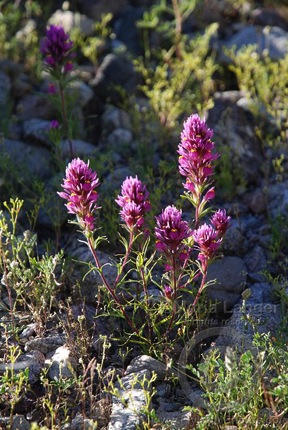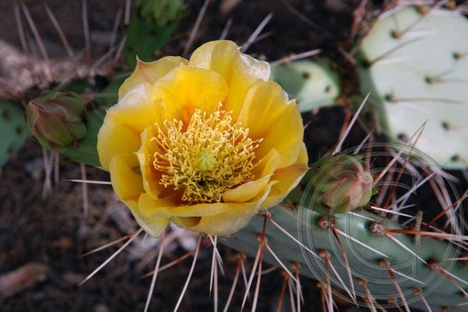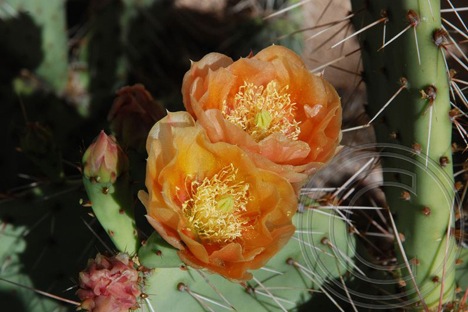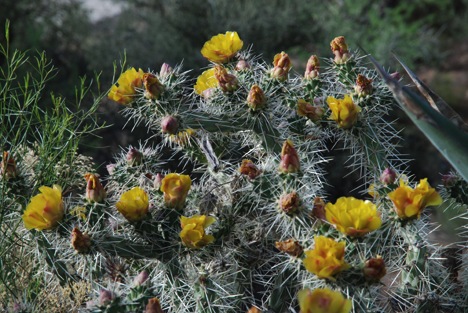I’m almost surprised we found it.
The wildflowers in the Sonoran desert around Wickenburg have been amazing lately — too amazing to ignore. So yesterday afternoon, I decided to tack a little PhotoJeeping excursion onto the end of my errands. Along the way, I picked up my friend Janet, who is an artist and likes photographing the desert almost as much as I do. We also squeezed in Jack the Dog and Janet’s dog, Maggie; they sat on the back seat beside the recycling bins.
At first, I’d considered another trip up Constellation Road. The last two times I was up there, the flowers hadn’t been blooming yet. Surely they must be blooming now. But when my errands called for a stop at the Shell gas station just south of town (they stock AeroShell aviation oil, if you can believe that), I thought about the desert southeast of Wickenburg. Dragon Mine was an old mine site I’d visited by Jeep years before with some friends. I thought that perhaps the juxtaposition of mining ruins and wildflowers might make a good subject.
Trouble was, I didn’t remember how to get there and hadn’t brought along my GPS.
So after one wrong turn that dead-ended in a subdivision, we tried another left turn off Grand Avenue and headed eastbound. The road wound through a subdivision and, at its east end, we spotted a dirt road winding down the side of a shallow canyon wall into San Domingo Wash. I followed the road.
Although this particular road had tire tread prints on it, the tracks were very close together. It wasn’t a Jeep road, it was an ATV road. It was painfully narrow at places — so narrow that I almost turned back several times. But I squeezed the Jeep through one narrow place after another, trying not to be bothered by the sound of branches scraping up against the side. I was glad I’d left the doors on; we would have been beaten up by thorny branches if I had taken them off. The floor of the canyon was rocky and then sandy and then rocky again, with short, steep climbs and tight turns. The Jeep, in 4H, performed admirably, as usual. The wheels spun just enough in those turns to give the illusion of a 90° turning radius sometimes. It was fun.
We stopped a few times to photograph flowers here and there. At one place, I captured a so-so image of lupines backlit by the sun, along with a shot of owl clover. The whole time, however, I was really looking for a trail that would take us out of the narrow track we were in. Something that would be easier to drive and get us to our destination — if we could find it — quicker.
Janet scouted ahead a one photo stop and found where the ATV trail climbed up a short hill to intersect with a nice dirt road. This was probably the road we were supposed to be on. I pulled up onto its relatively smooth and definitely wide surface, glad to be out of the wash.
We continued mostly eastbound, heading toward the low mountains in line with San Domingo Peak. As we drove, we kept a sharp eye out for the wildflowers we wanted to photography. The light was behind us and relatively low; it was nearly 5 PM and the sun would set in less than two hours. That gave us a great view of the scenes on either side of the road as we traveled east.

This “Desert Still Life” features a strawberry hedgehog cactus, the “skeleton” of a cholla cactus, a blooming creosote bush, and an iconic saguaro cactus, all under a perfectly blue Arizona sky. (Click for a larger view.)
I caught sight of a blooming hedgehog cactus about 100 feet off the side of the road and pulled to a stop. We got out and explored the area on foot. I’ve been trying hard to do all my photos with a tripod these days and although it’s a bit of a pain in the butt, I admit that I am getting used to it. After doing a few ho-hum horizontal shots of the cactus and its flowers, I scrunched down on the ground and took a look though the lens, holding it vertically. I liked what I saw. I made several shots, with and without a polarizing filter and at different angles to get the photo you see here.
There’s a certain feeling I get when I know I’ve captured a good image. I’ve felt it before, several times. I can see the image in the tiny video screen at the back of the camera, but as I age, my close vision is deteriorating so I can never really see it to be sure. It’s only when I get back home to my computer and can view it on a 24″ monitor that I know whether it’s good. I’ve been disappointed many times, but not this one. I’m very pleased with this image and think it might just be the best I’ve ever captured.
I didn’t know that for sure yet, so the rest of the trip was a slow drive toward our intended destination with me wondering whether I’d be disappointed. We made several stops and took more photos along the way. For a while, it seemed to me that the road was getting too close to the mountains. But then it swung to the north and we passed a big flat area that I remembered being south of the mine. A while later, we rolled up to the mine site and climbed out.
The shots I took there weren’t anything special. There’s a lot of concrete shapes, such as the stairs you see here, and plenty of metal and wood. There are two mine shafts — a vertical one at the top of a small hill and a horizontal one that enters the area from the small wash on the north side. They might join somewhere under ground; I don’t know and don’t plan on every finding out. (Exploring mines is dangerous, folks.)
It was nearly 6 PM when we were ready to move on. I was hoping to take a different and better route back. So we continued along a road that headed west from the mine. I was pretty sure it was the road I’d taken back on our last visit years before. But it swung around to the north and then the northeast. This was wrong. We wanted to head west or northwest. My gut told me to follow it, but my brain reminded me we were headed in the wrong direction. Sunset was in less than an hour and the light wouldn’t last long afterward. I told Janet that she should never allow me to take her out in the desert again without my GPS.
We followed the road for another five minutes. It headed east and north and northeast. Just when I was getting ready to turn around, it intersected with a broad, sandy wash. The tire tracks of previous travelers headed up and down the wash. Down the wash was west, so we made the left turn. I threw the Jeep back into 4H and we sped down the wash.
It was a long drive — maybe as many as 5 miles. The wash twisted and turned, but always headed mostly west. The sun, now very low in the sky, cast long shadows that shielded our eyes from the glare when the canyon walls were high, then blinded us when the canyon walls dropped. It turns out that we were in Monarch Wash. We passed through a gate that had been left open — without a “Keep Gate Closed” sign, we left it that way — and eventually wound up on Grand Avenue, about a mile north of where we’d turned off nearly three hours before.
It was a good little trip that might have been made better by having my GPS along. (Frankly, I still can’t figure out why so many people depend on them when traveling on paved roads with signs. But that’s another blog post.) Best of all, I managed to capture one of the best images I’ve made so far. That’s plenty of reward for the dust in my hair and clothes.













